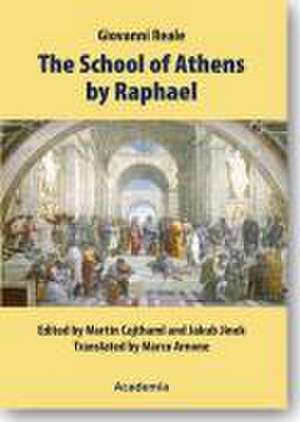The Schools of Athens by Raphael
Editat de Martin Cajthaml, Jakub Jineken Limba Engleză Hardback – 8 apr 2008
Preț: 194.74 lei
Nou
Puncte Express: 292
Preț estimativ în valută:
37.30€ • 38.43$ • 31.24£
37.30€ • 38.43$ • 31.24£
Carte indisponibilă temporar
Doresc să fiu notificat când acest titlu va fi disponibil:
Se trimite...
Preluare comenzi: 021 569.72.76
Specificații
ISBN-13: 9783896653772
ISBN-10: 3896653776
Pagini: 152
Dimensiuni: 154 x 218 x 17 mm
Greutate: 0.38 kg
Editura: Academia Verlag GmbH
ISBN-10: 3896653776
Pagini: 152
Dimensiuni: 154 x 218 x 17 mm
Greutate: 0.38 kg
Editura: Academia Verlag GmbH
Notă biografică
Giovanni Reale (1931) graduated at the Catholic University of Milan (Italy) and continued his postgraduate studies on ancient thought at Marburg and Munich (Germany). He has thought History of Ancient Philosophy at the Catholic University of Milan, where he founded a Centre for Platonic Studies, and now teaches at the new Philosophy Department of the Università San Raffaele, Milan (Italy).For the Bompiani Publishing House he is responsible for the series 'Testi a Fronte' and 'Il Pensiero Occidentale'.He has applied the canons of contemporary hermeneutics and epistemology to the study of Greek philosophy, showing that it is at the roots of Western culture.His research covers the whole spectrum of ancient thought, both pagan and Christian.Reale's main publications are the following: Il concetto di filosofia prima e l'unità della Metafisica in Aristotele, Vita e Pensiero, Milan, 1994; Storia della Filosofia Antica, 5 volls, Vita e Pensiero, Milan, 1975-80 (with several later editions); Per una nuova interpretazione di Platone, Vita e Pensiero, Milan, 1997; Saggezza Antica, Cortina, Milan, 2000; Eros dèmone e mediatore. Il gioco delle maschere nel Simposio di Platone, Rizzoli, Milan, 2000; Platone. Alla ricerca della sapienza segreta, Rizzoli, Milan, 1998; Platone. Fedro (editio maior), Lorenzo Valla-Mondadori, 1998; Platone. Simposio (editio maior), Lorenzo Valla-Mondadori, 2001; Corpo, anima e salute, Cortina, Milan, 1999; Socrate. Alla ricerca della sapienza umana, Rizzoli, Milano 2000. Together with Dario Antiseri he has also published Il pensiero occidentale dalle origini ad oggi, La Scuola, Brescia (translated also in Russian) and Quale ragione?, Cortina, Milano, 2001.The following publications that Reale edited for Bompiani are considered a benchmark by scholars of ancient philosophical thought: Tutti gli Scritti by Plato; Metaphysica by Aristotle; Tutti gli scritti by Seneca; Amore assoluto by [St.Augustin]. Together with R. Radice, he has edited a new edition of Plotinus' [Enneades] in the Meridiani series of Mondadori, Milan, 2002.Reale has also applied the canons of hermeneutics to the interpretation of some art masterpieces inspired by Platonism, namely the three Raphael masterpieces in the Vatican's 'Stanza della Segnatura': Raffaello. La 'Scuola di Atene' (1997, completely revisited in the present second edition 2005); Raffaello. La 'Disputa' (1998); Raffaello. Il 'Parnaso' (1999). With similar hermeneutic canons he has also written Botticelli. La 'Primavera' o le 'Nozze di Filologia e Mercurio?' (Idea Libri, 2001).Giovanni Reale (1931) is internationally recognized as a leading scholar of ancient thought. His works have appeared in English, German, Spanish, Portuguese, Russian, Polish and Croat; they are also being translated in French, Rumanian, Czech and Ukrainian.
